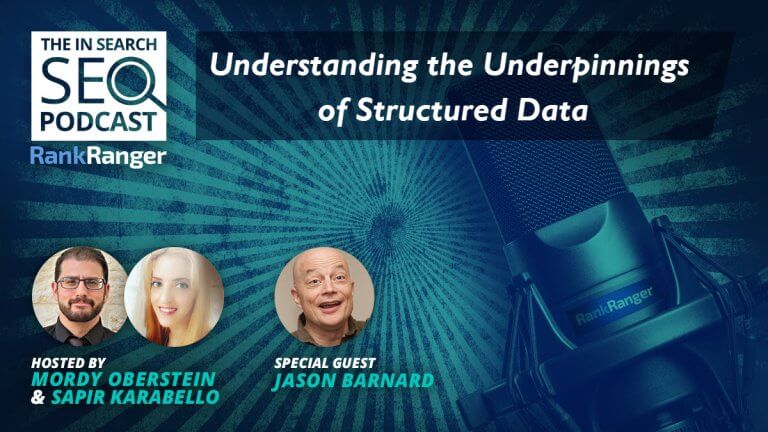 Marketing Intelligence
Marketing Intelligence
In Search Podcast: Understanding the Underpinnings of Structured Data

Don’t forget, you can keep up with the In Search SEO Podcast by subscribing on iTunes or by following the podcast on SoundCloud!
Summary of Episode 46: Going Deep Into Structured Data & SEO Importance!
This week we have the wonderful, the delightful, the musical, semantic SEO specialist Jason Barnard here to talk with you all about rich results & structured data markup:
- Why the “block construct” is so important to Google & what it means for your rich results
- The changing relationship between rich results and traffic to your site
- Thinking about structured data beyond clicks
Plus, we take a look at what you could do after being hit by a core update!
Is There Really Nothing to do About Google’s Core Updates? [00:06:44 – 00:18:52]
One thing that caught Mordy’s attention recently was a statement from Gary Illyes of Google who said that bad links to your site are not what’s behind being impacted by the core updates. Mordy, personally, doesn’t think links, in general, are behind the core updates as he believes core updates are the antithesis of links. Meaning, the core updates are all about Google trying to go beyond links and look at content/sites/pages more intrinsically. As Mordy’s mentioned in the past, links are an indirect signal. It’s like judging a meal based on how it looks. It may look great, but it could taste terrible in reality.
Anyways, during this Twitter talk, Mordy got into a nice conversation with Dr. Pete over at Moz about Google’s response/advice to dealing with core updates… which according to Google… is basically to do nothing but create good content. Both Dr. Pete and Mordy just can’t understand why Google says this. Why make these zero-sum statements with no ray of hope?
We know there’s more that can be done after a core update because NOTHING has been as rich and robust when it comes to driving the SEO conversation as the core updates!
Think about it. What’s driven the renewed focus on E-A-T? The core updates! What’s driven the conversation about the QRG vis-a-vis the algorithm? The core updates! What’s driving the conversation about the importance of authority? The core updates! And what introduced the notion of Google being able to take a more qualitative look at content? The core updates!
Yet, despite all of that, we’re supposed to believe there’s nothing to learn from them?!
Let’s look at a case from the last core update, the September 2019 Core Update. Mordy did a piece analyzing the update and one of the things he saw was an interesting pattern among some of the financial sites that lost rankings during the update.
There seemed to be a lot of loan sites impacted by the update so Mordy decided to dive in a bit by comparing the loan sites hit by the September update to those that got through it unscathed. Upon doing so, one of the things that stood out like a sore thumb was the tone of the content.
There were many pages offering a lot of content, or at least what seemed to be comprehensive content, that got hit by the update. But Google seemed to want more than just a comprehensive look at a topic. After comparing the sites that were and weren’t affected by the update it seemed pretty obvious what was going on… Google was interested in how the topic was approached, not only how well it was covered. That is, the “good” sites had no marketing talk in their content on loan information… none. It was all business, straightforward, helpful, and informative content.
The other sites, on the other hand, the ones that got hit, had a lot of content on the page and a lot of good details about the loans they are peddling but within that information was a tinge of marketing. Just a few lines about why this loan type is just the thing for you.
Meaning, it became clear that Google was able to differentiate between pure information and content that while not thin or pure sales talk, is not 100% purely informative.
This type of content analysis is what Google has been striving for years. It’s almost like Google was able to analyze the word choice and as a result, backhandedly pick up on the content’s tone and when that tone was not 100% pure information, Google couldn’t trust it.
But, according to Google, there’s nothing to do and nothing to learn from core updates. As Mordy said, “it’s just so bizarre!”
On the Role & Importance of Structured Data: A Conversation with Jason Barnard [00:18:52 – 00:59:21]
[This is a general summary of the interview and not a word for word transcript. You can listen to the podcast for the full interview.]
Mordy: Welcome to another In Search SEO Podcast interview session and do we have a delicious treat for you today. He is a top-notch SEO consultant, an industry author, and search marketing speaker. He has the best vocal pipes in the industry and is fittingly the host of the SEO is AEO podcast. He is Jason Barnard!
Welcome!
Jason: Thank you for that. Yes, I do like singing and singing the introduction to my SEO is AEO podcast is so much fun.
M: Fun fact. You have an IMDB page, correct?
J: I do. That’s because I did the voice over for five characters including a blue dog about ten years ago. My wife and I were doing this cartoon with two characters for 3 – 4 years and then we noticed that in order for it continue we’ll need to add in more characters. So I had to do some of the voices. We even wrote in my daughter as blue dog’s little sister.
M: Wow, now I’m really tempted to find this cartoon.
So we are going to talk today about rich results. Just to get us all on the same page, what is a rich result?
J: So I’ve been calling them rich elements because to me they’re just elements within a page. To say these are rich results you can say for all Google search results because they’re all rich. The idea for a rich element for me is position zero, the Knowledge Graph, Google My Business, Maps, images, carousels, People Also Ask, and FAQs (which have gone completely nuts in their volume). All of these make Google’s results look richer and richer. Whether you call them rich results or rich elements it’s the same, but rich elements are nice because it ties into blocks which we’ll come to later.
M: Rich Results and the markup that produces them have become a cornerstone of the SEO conversation. How did this happen? Why the rise of the rich result?
J: How it has risen is because users want this rich content. Users would originally have to click on the SERP to get this content so Google decided to put it directly onto the SERP which makes sense. If Google’s aim is to get the user to the answer to their question as quickly and efficiently as possible, it’s clear it has to be on their results. This all goes to having a sort of neutral empathy towards Google, an understanding of their point of view. It’s incredibly helpful for us as SEOs to know what Google is doing to fulfill its needs.
M: Okay, so with the audience on the same page let’s really get into this. You have a 3 pillar construct that I’d love to get into.
One of the foundations of that is “blocks.” Can you please explain what you mean and how it ties into “rich results?”
J: My concept of blocks is that if you think in blocks everything makes much more sense. If you look at the World Wide Web, your website is simply a block within that World Wide Web. Within your website, you have categories that are blocks. Within those categories, you have pages that are blocks. Within pages, everything in there is a block, your header, article, sidebar, footer, and even H1s and H2s are blocks. So you have blocks within blocks within blocks. Then all of the rich results are blocks too. This makes sense for us as humans and to machines it makes even more sense.
M: And why is that?
J: Because machines need to think in terms of relationships between entities where each block is an entity with a relationship like a parent to a child. If we look at that all of the machines are working on graph theory, entities connect to each other by relationships, blocks make perfect sense.
If you look at linking it’s actually an entity which is a page but also a block linked to another entity which is also a page and a block.
Basically, the block is what allows Google to pull out the rich result and put it on the SERP. It allows Google to construct in its mind the web as blocks/entities with relationships.
M: Do you think Google analyzes each block as its own entity?
J: Cindy Krum, and I agree, thinks that Google is indexing in blocks. So a page is a block, but it will also index a block within a block. If you look at Gutenberg in WordPress, that is a great way as a human being to visualize what’s going on. It forces you to structure, it forces you to think in blocks. You’re feeding a machine (Google) and in order for it to send you website traffic you have to present it information in a manner that it can digest easily.
M: Right, I don’t think people understand that Google has limited resources and it wants to see information in the least resource-heavy way possible. It is a funny thing though that Google says it can do these things without markup via machine learning. I’m wondering what you think. Will Google move more in the direction of using machine learning or for the sake of simplicity and using limited resources it will always rely on schema markup?
J: Right now I think of schema markup as a way to confirm to Google what is on your page. I believe Google relies on this precision that we give them so why would they stop?
M: That’s right. There’s really no advantage to machine learning. Why would they do the work themselves when you would do it for them?
J: Exactly. Schema markup is going to be here for a while and anyone not doing it today is liable to miss the boat.
M: There’s a lot of talk about the advantages of using rich results to steer traffic to your site. Is that going to become less of a “thing” with the advent of rich and prolific formats such as the FAQ or How-to? Aren’t the answers now just on the SERP? Are we moving to rich results being a part of Google’s answer engine identity?
J: Yes, we are losing traffic, but maybe one way to change our perspective is to say that my website is one representation of my brand that I completely control. The SERP is another representation of my brand or whatever keywords people are searching and I need to add my brand to that, to get my message across. It’s not just adding in keywords and a meta description. It’s getting my brand message in there so even if they don’t click they’ve read it.
Google is, in a way, phasing out links in search. At the moment, Google doesn’t have as many videos as it would like so maybe the better way to rank nowadays is through video.
M: Right, also for audio content. All things being equal there’s very little audio content.
J: Exactly. I would sometimes ask my clients if they want to consider doing a podcast and they said, “Who cares about podcasts? They don’t rank.” And that’s the point because Google doesn’t have the content. We need to create content that fills these multimedia gaps that Google’s super-rich SERPs are lacking and that users are demanding.
To further bring it out, your social networks is a representation of your brand, your reviews are a representation of your brand. If you take a step back and see that you have all of these representations of your brand which some you control fully and some partially. Your aim is to communicate your message of what you’re offering and why they should buy from you and then they’ll get to your site, presumably when they’re ready to buy.
M: How do you do that though? Or what are some creative ways you’ve seen in getting your message across via the SERP without the click?
J: For the moment, I don’t know if anyone has had any great ideas. Usually with clients, after making sure the technical SEO is good, we then move on to what content can you create to get on the SERP. The idea of creating content for these rich spots shouldn’t be who has the spot, it’s which queries don’t have this rich element that will benefit from it.
I have clients who think all they need to do is write some blog posts. But with blog posts, you’re competing with all the other competing blue links and you’ll need a ton of backlinks into your blog page. You need to optimize the page and put in loads of investment to get anywhere near the top page. But, if you see a SERP that needs a video and doesn’t have one, then create a video. If you think audio will be better then do that. Same for the image gallery or Featured Snippets.
You can also take your content and create it like a series of content, make it episodic. The idea is to give your content this coherence like a TV series. You have your body of work and its elements and each element is for a specific query or topic.
As digital marketers, we can’t look back at the early days and hang our heads and sulk. We need to figure out how to deal with it. Two things are obvious: 1) We’re never going to get that level of traffic again, and 2) The traffic we are getting will have to be much more qualified and we’ll have to find new ways to drive that traffic. As we said early on, people haven’t come up with good ideas, but that doesn’t mean good ideas aren’t going to come.
M: So what’s next? Where do we go from here? We know that Google is obsessed with adding media to the SERP.
J: As I said, we’re looking for qualified visits as opposed to people looking for the weather or the size of a t-shirt. Creating quality, interactive multimedia content that is of true interest to your users. Rather than looking at content think of solutions. What solution am I providing? And not just that, but am I providing a solution to Google’s users? Then I need to prove to Google that I have the correct solution for their users in that context. If your content is cursory, then Google will keep it, if it is more qualified and deeper content then Google will give it to you. If I had one philosophical idea for the future it will be that.
Optimize It or Disavow It
M: If you’re a commerce site and you could only do one, would you create markup for Products or the ever-sexy FAQ/How-to?
J: I will say product simply because it’s nearer to the sale and we’re looking to make money. We get over-excited with new toys like voice search, but that’s really just a toy. It’s a generational thing. 15 years ago it was images and now its voice as the younger generation are talking to their machines.
Coming back to FAQ, which has completely exploded in popularity, I have two things to say. One, it’s too early in the buying process (not that you shouldn’t do it, you should) and the second thing is that FAQ is great for the after-sale. If your clients are looking for an answer to a specific question and can’t find an answer they may leave a bad review so FAQs are a great way to keep your clients informed.
M: Thank you, Jason. I really appreciate you coming on. It was so much fun.
J: It was amazing to be on. Thanks for having me.
Tune in next Tuesday for a new episode of The In Search SEO Podcast.
The #1 keyword research tool
Give it a try or talk to our marketing team — don’t worry, it’s free!






